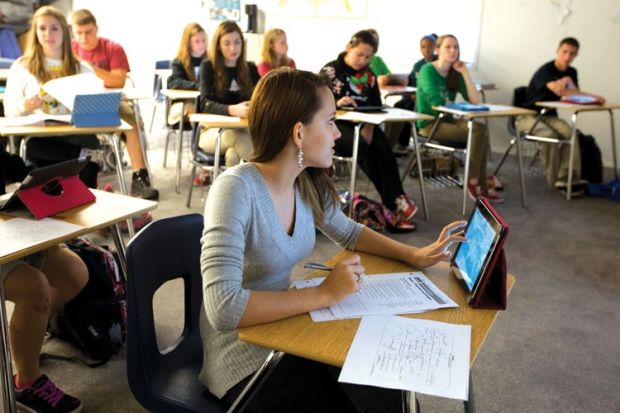Source: Alamy
Lower-priced learning: OER textbooks are easier on the wallet
Several US projects launched this autumn are expanding the availability of free electronic textbooks using open educational resources (OER) as commercial publishers scramble to make more of their own titles available digitally.
The activity comes in response to the mounting cost of textbooks – up 812 per cent since 1978, far faster than even tuition fees, according to the American Enterprise Institute thinktank.
“A lot of students don’t even buy the book,” said Richard Baraniuk, professor of engineering at Rice University in Houston and founding director of OpenStax College, an OER project based there.
“They know they’re not going to do as well in the course, but they still choose not to buy the book because it’s too expensive.”
Impatient for publishers to rein in costs, Lynn University in Florida has provided tablets to all incoming students this term and said it would eliminate printed textbooks in core classes by next year.
Pushed by student associations, the University System of Maryland is letting academics experiment with free OER textbooks in introductory courses. And several start-ups, eyeing a US textbook market worth more than $12 billion (£7.6 billion), are promoting cheap alternatives created from OER content.
Publishers are pushing back in unexpected ways. Many now offer cheaper e-versions of their textbooks (online products now account for per cent of the US industry).
Global publisher Pearson has also created a cloud-based service that provides access to free OER content alongside its titles, allowing scholars to assemble their own course materials from both sources. And a group of publishers has collectively made its e-titles available through a service called CourseSmart.
Revolution delayed
But although these trends have been building for a few years, the digitisation of textbooks has not taken off as fast as other technological advances in the academy.
For one thing, staff and students have been surprisingly reluctant to abandon print.
Nearly 80 per cent of students surveyed by the National Association of College Stores say they prefer print to e-books, and academics assign digital texts in only 14 per cent of courses.
In focus groups conducted by the Center for Studies in Higher Education at the University of California, Berkeley, faculty said they were concerned about whether the authors of OER textbooks were adequately paid, whether the quality was sufficient and whether the content was objective.
OER textbooks do remain limited in scope and number. OpenStax, supported by grants from sources including the Bill and Melinda Gates Foundation, provides titles for just five introductory courses.
Nevertheless, OpenStax estimates that it will save 40,000 students a collective $3.7 million this year, or an average of $92.50 per student.
It is also looking for ways to keep going once foundation support dries up. One potential avenue is to team up with for-profit providers of computer-based class assignments, which could also offer OER content for a small fee.
“Certain business models are going to be obviated and certain ones are going to arise,” Professor Baraniuk said. “Some will succeed and be stronger. And some will fail.”
Register to continue
Why register?
- Registration is free and only takes a moment
- Once registered, you can read 3 articles a month
- Sign up for our newsletter
Subscribe
Or subscribe for unlimited access to:
- Unlimited access to news, views, insights & reviews
- Digital editions
- Digital access to THE’s university and college rankings analysis
Already registered or a current subscriber? Login




